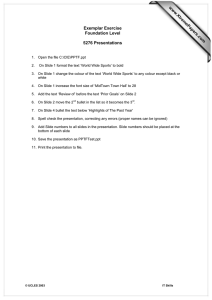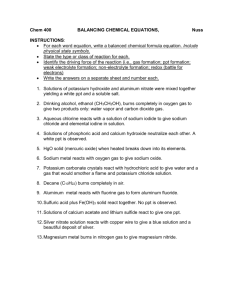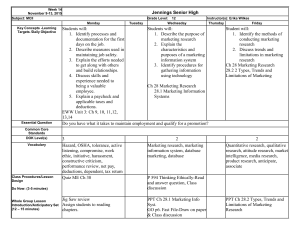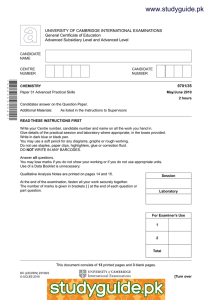www.XtremePapers.com
advertisement
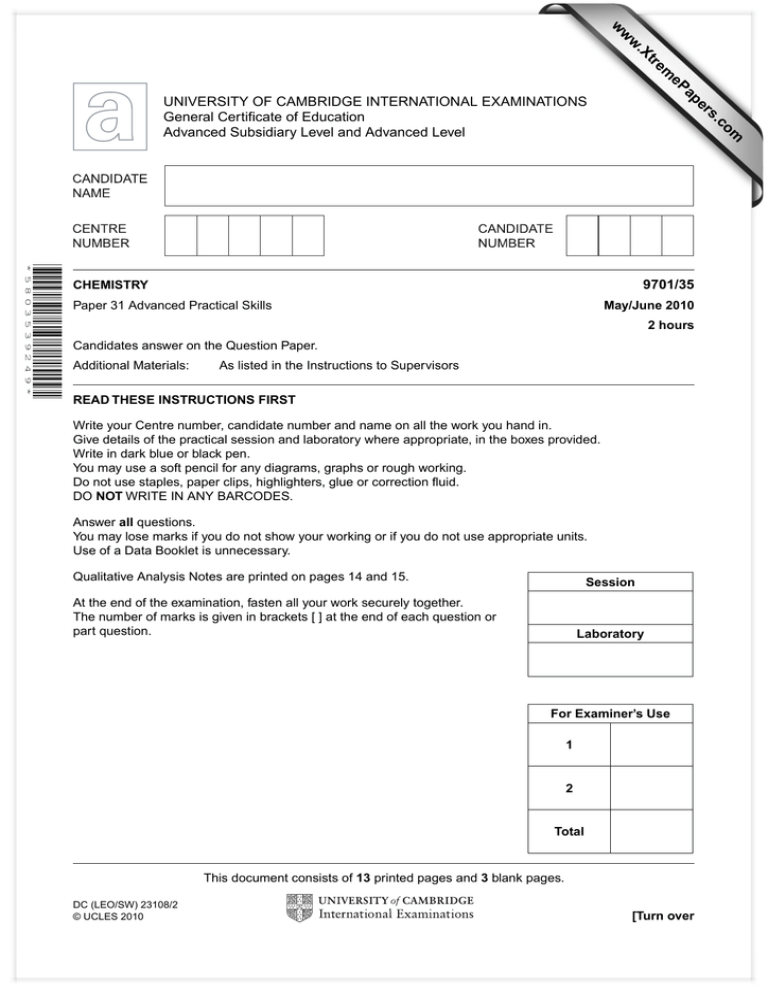
w w ap eP m e tr .X w om .c s er UNIVERSITY OF CAMBRIDGE INTERNATIONAL EXAMINATIONS General Certificate of Education Advanced Subsidiary Level and Advanced Level *5803539249* 9701/35 CHEMISTRY Paper 31 Advanced Practical Skills May/June 2010 2 hours Candidates answer on the Question Paper. Additional Materials: As listed in the Instructions to Supervisors READ THESE INSTRUCTIONS FIRST Write your Centre number, candidate number and name on all the work you hand in. Give details of the practical session and laboratory where appropriate, in the boxes provided. Write in dark blue or black pen. You may use a soft pencil for any diagrams, graphs or rough working. Do not use staples, paper clips, highlighters, glue or correction fluid. DO NOT WRITE IN ANY BARCODES. Answer all questions. You may lose marks if you do not show your working or if you do not use appropriate units. Use of a Data Booklet is unnecessary. Qualitative Analysis Notes are printed on pages 14 and 15. Session At the end of the examination, fasten all your work securely together. The number of marks is given in brackets [ ] at the end of each question or part question. Laboratory For Examiner’s Use 1 2 Total This document consists of 13 printed pages and 3 blank pages. DC (LEO/SW) 23108/2 © UCLES 2010 [Turn over 2 BLANK PAGE © UCLES 2010 9701/35/M/J/10 3 1 You are required to find the molar enthalpy change for the decomposition of sodium hydrogencarbonate, NaHCO3. NaHCO3 For Examiner’s Use ½Na2CO3 + ½H2O + ½CO2 FA 1 is anhydrous sodium hydrogencarbonate. FA 3 is 4.0 mol dm–3 hydrochloric acid. FA 2 is anhydrous sodium carbonate. You will determine the value for the molar enthalpy change of neutralisation for each of FA 1 and FA 2, using an excess of FA 3. You will then use these values to calculate the molar enthalpy change for the decomposition of sodium hydrogencarbonate. Warning: 4.0 mol dm–3 hydrochloric acid is an irritant. Very rapid effervescence occurs when FA 1 or FA 2 are added to FA 3. For safe working, and to minimize the formation of ‘acid mist’, the solid must be added carefully, with stirring, to the acid. See further instructions below. Before starting any practical work read through the instructions in (a) and draw up two tables to record your results. © UCLES 2010 9701/35/M/J/10 [Turn over 4 (a) Determining the molar enthalpy change of neutralisation between FA 1 and FA 3 NaHCO3 + HCl NaCl + H2O + CO2 Follow the instructions below to determine the temperature change when a known mass of FA 1, sodium hydrogencarbonate, reacts with an excess of FA 3, hydrochloric acid. • • • • • • • • • • • • Weigh the stoppered tube labelled FA 1 containing sodium hydrogencarbonate. Use a 50 cm3 measuring cylinder to transfer 50 cm3 of FA 3 into a 250 cm3 beaker. Stir the acid in the beaker with the thermometer. Record the temperature of the acid; this is the temperature at t = 0 min. Record the temperature each minute for 3 minutes. At t = 4 min, start to carefully add the weighed sample of FA 1 to the acid. Add the solid in at least 4 or 5 portions to prevent excessive effervescence. While adding the solid stir the mixture constantly with the thermometer, but do not record the temperature. Continue to stir the mixture throughout the experiment. Record the temperature at t = 5 min, then every ½ minute until t = 8 min. Reweigh the tube labelled FA 1, its stopper and any residual sodium hydrogencarbonate. Empty and rinse the beaker and dry it using a paper towel. In one of your tables record the balance readings and the mass of FA 1 added; in the second table record all measurements of time and temperature. Table of results [3] © UCLES 2010 9701/35/M/J/10 For Examiner’s Use 5 (b) Graph plotting 1. 2. 3. 4. Plot a graph of temperature (y-axis) against time (x-axis) on the grid below. Draw two straight lines of best fit; one through the points up to t = 3 min; the second through the points from t = 5 min to t = 8 min. Extrapolate both lines to t = 4 min. From the extrapolated lines read the minimum and the maximum temperatures at t = 4 min. Record these values in the spaces provided below. Determine the value for the temperature fall at t = 4 min. For Examiner’s Use The minimum temperature at t = 4 min is …………. °C. The maximum temperature at t = 4 min is ………… °C. The temperature fall, ΔT1, at t = 4 min is ………… °C. [4] © UCLES 2010 9701/35/M/J/10 [Turn over 6 (c) Calculations For Examiner’s Use Working should be shown in all calculations. (i) Use the equation below and the temperature fall, ΔT1, from (b) to calculate the change in heat energy during the reaction of FA 1 with FA 3. change in heat energy = 50 × 4.3 × ΔT1 The change in heat energy = .................. J. (ii) Calculate how many moles of FA 1, NaHCO3, were used in your experiment. [Ar; C, 12.0; H, 1.0; O, 16.0; Na, 23.0] .................. mol of FA 1 were used in the experiment. (iii) Calculate the enthalpy change when 1 mol of FA 1 reacts with an excess of the hydrochloric acid, FA 3. This is the molar enthalpy change of neutralisation, ΔHneutralisation (NaHCO3). Make certain that your answer is given in kJ mol–1 and has the appropriate sign. ΔHneutralisation(NaHCO3) = ........ sign (iv) ............................ kJ mol–1. calculated value Explain the significance of the sign you have given in (iii) and how it is related to your experimental results. .................................................................................................................................. .................................................................................................................................. .................................................................................................................................. [3] © UCLES 2010 9701/35/M/J/10 7 BLANK PAGE © UCLES 2010 9701/35/M/J/10 [Turn over 8 (d) Determining the molar enthalpy change of neutralisation between FA 2 and FA 3 Na2CO3 + 2HCl 2NaCl + H2O + CO2 Follow the instructions below to find the temperature change when a known mass of FA 2, sodium carbonate, reacts with an excess of FA 3, hydrochloric acid. You are provided with two samples of sodium carbonate. You should use the sample labelled Na2CO3 in experiment 1 and the sample labelled FA 2 in experiment 2. Experiment 1 • Enter all results in the table below. • Weigh the stoppered tube containing sodium carbonate, which is labelled Na2CO3. • Use a 50 cm3 measuring cylinder to transfer 50 cm3 of FA 3 into the rinsed and dried 250 cm3 beaker used in (a). • Stir the acid in the beaker with the thermometer and record the temperature. • Start to add carefully the weighed sample of Na2CO3 to the acid. • As in the experiment in (a), add the solid in at least 4 or 5 portions to prevent excessive effervescence. • While adding the solid stir the mixture constantly with the thermometer. • Record the maximum temperature obtained during the reaction. • Reweigh the tube labelled Na2CO3, its stopper and any residual sodium carbonate. • Empty and rinse the beaker and dry it using a paper towel. Experiment 2 • Enter all results in the table below. • Weigh a clean, dry, boiling-tube. • Weigh between 7.0 g and 7.5 g of FA 2, sodium carbonate, into the boiling-tube. • Repeat the procedure in experiment 1 and record the maximum temperature obtained when this mass of FA 2 reacts with 50 cm3 of FA 3. • Reweigh the boiling-tube and any residual sodium carbonate. Results experiment 1 experiment 2 mass of tube + anhydrous sodium carbonate / g mass of empty tube / g mass of tube + residual sodium carbonate / g mass of anhydrous sodium carbonate / g initial temperature of acid / oC maximum temperature obtained / oC temperature rise, ΔT2 / oC [6] © UCLES 2010 9701/35/M/J/10 For Examiner’s Use 9 (e) Calculations For Examiner’s Use Working should be shown in all calculations. (i) Use the equation below and the temperature rise, ΔT2, from (d) for experiment 1 to calculate the change in heat energy during the reaction of sodium carbonate with FA 3. change in heat energy = 50 × 4.3 × ΔT2 Change in heat energy = .................. J. (ii) Calculate how many moles of sodium carbonate were used in your experiment 1. [Ar; C, 12.0; O, 16.0; Na, 23.0] .................. mol of sodium carbonate were used in experiment 1. (iii) Calculate the enthalpy change when 1 mol of sodium carbonate reacts with an excess of the hydrochloric acid, FA 3. This is the molar enthalpy change of reaction, ΔHneutralisation(Na2CO3). Make certain that your answer is given in kJ mol–1 and has the appropriate sign. ΔHneutralisation(Na2CO3) = ........ sign (iv) ............................ kJ mol–1. calculated value Explain the significance of the sign you have given in (iii) and how it is related to your experimental results. .................................................................................................................................. .................................................................................................................................. .................................................................................................................................. [5] © UCLES 2010 9701/35/M/J/10 [Turn over 10 (f) Calculating the enthalpy change of decomposition of FA 1, ΔHdecomposition(NaHCO3) Use your values for ΔHneutralisation (NaHCO3) and ΔHneutralisation (Na2CO3) in the expression below to calculate a value for the molar enthalpy change of decomposition, ΔH decomposition (NaHCO3), for FA 1. ΔH decomposition (NaHCO3) = ΔHneutralisation (NaHCO3) – ½ΔHneutralisation (Na2CO3) ΔHdecomposition(NaHCO3) = ........ sign ............................ kJ mol–1. calculated value [1] (g) Evaluation An alternative method for the determination of ΔHdecomposition (NaHCO3) gave a value of +42.5 kJ mol–1. The value you have obtained may be significantly different from this value. Calculate the difference between your value of ΔHdecomposition (NaHCO3) and that obtained by the alternative method. Record this difference below. Express this difference as a percentage of the alternative value. difference = ………………. kJ mol–1 percentage difference = ……………….. % [1] (h) Sources of error Describe one major source of error in this experiment. Suggest an improvement which would significantly increase the accuracy of the experiment. Explain why your suggestion would produce a more accurate value. description of major source of error ......................................................................................................................................... ......................................................................................................................................... suggested improvement ......................................................................................................................................... ......................................................................................................................................... explanation of why suggestion would increase experimental accuracy ......................................................................................................................................... ......................................................................................................................................... [2] [Total: 25] © UCLES 2010 9701/35/M/J/10 For Examiner’s Use 11 2 (a) You are provided with three solutions, FA 4, FA 5 and FA 6. The only anions that may be present in these solutions are carbonate and chloride. One or more of the solutions may contain both anions. For Examiner’s Use Identification of the anions in FA 4, FA 5 and FA 6 Most metal carbonates are insoluble, most metal chlorides are soluble and all metal nitrates are soluble in water. (i) Use this information and the Qualitative Analysis Notes on page 15 to select • reagent 1, to identify any carbonate ion that is present, • reagent 2, to identify any chloride ion present. reagent 1 ............................................. reagent 2 ............................................. [1] (ii) Explain the order in which you will add your chosen reagents to determine the anion or anions present in each of FA 4, FA 5 and FA 6. .................................................................................................................................. .................................................................................................................................. ............................................................................................................................. [1] (iii) Use the reagents selected in (a)(i) to test each of the solutions FA 4, FA 5 and FA 6. Record your observations in the table below. observations reagent FA 4 FA 5 FA 6 [2] (iv) solution From your observations, identify the anion or anions present in each of the solutions. carbonate chloride evidence FA 4 FA 5 FA 6 [2] © UCLES 2010 9701/35/M/J/10 [Turn over © UCLES 2010 9701/35/M/J/10 (iii) (ii) (i) FA 7 FA 8 FA 9 The reagent is Select a reagent that will confirm the identity of any ions producing white precipitates in both of the tests above. To about 1 cm depth of solution in a test-tube add the selected reagent. Record the appropriate observations below. add a further 2 cm depth of aqueous ammonia. To about 1 cm depth of solution in a test-tube, add 10 drops of aqueous ammonia, shake the mixture then, add a further 2 cm depth of aqueous sodium hydroxide. To about 1 cm depth of solution in a test-tube, add 5 drops of aqueous sodium hydroxide, shake the mixture then, tests observations FA 10 [7] (b) You are provided with four solutions, FA 7, FA 8, FA 9 and FA 10. Perform the test-tube experiments described below and record your observations in the table. 12 For Examiner’s Use i ii iii iv v vi vii 13 (c) From your observations, identify the cation present in each of the following solutions. solution cation For Examiner’s Use evidence FA 7 FA 9 FA 10 [2] [Total: 15] © UCLES 2010 9701/35/M/J/10 14 Qualitative Analysis Notes Key: [ ppt. = precipitate. ] 1 Reactions of aqueous cations reaction with ion NaOH(aq) NH3(aq) aluminium, Al 3+(aq) white ppt. soluble in excess white ppt. insoluble in excess ammonium, NH4+(aq) no ppt. ammonia produced on heating – barium, Ba2+(aq) no ppt. (if reagents are pure) no ppt. calcium, Ca2+(aq) white ppt. with high [Ca2+(aq)] no ppt. chromium(III), Cr3+(aq) grey-green ppt. soluble in excess giving dark green solution grey-green ppt. insoluble in excess copper(II), Cu2+(aq) pale blue ppt. insoluble in excess blue ppt. soluble in excess giving dark blue solution iron(II), Fe2+(aq) green ppt. turning brown on contact with air insoluble in excess green ppt. turning brown on contact with air insoluble in excess iron(III), Fe3+(aq) red-brown ppt. insoluble in excess red-brown ppt. insoluble in excess lead(II), Pb2+(aq) white ppt. soluble in excess white ppt. insoluble in excess magnesium, Mg2+(aq) white ppt. insoluble in excess white ppt. insoluble in excess manganese(II), Mn2+(aq) off-white ppt. rapidly turning brown on contact with air insoluble in excess off-white ppt. rapidly turning brown on contact with air insoluble in excess zinc, Zn2+(aq) white ppt. soluble in excess white ppt. soluble in excess [Lead(II) ions can be distinguished from aluminium ions by the insolubility of lead(II) chloride.] © UCLES 2010 9701/35/M/J/10 15 2 Reactions of anions ion carbonate, reaction CO2 liberated by dilute acids CO32– chromate(VI), CrO42– (aq) yellow solution turns orange with H+(aq); gives yellow ppt. with Ba2+(aq); gives bright yellow ppt. with Pb2+(aq) chloride, gives white ppt. with Ag+(aq) (soluble in NH3(aq)); Cl – (aq) gives white ppt. with Pb2+(aq) bromide, gives cream ppt. with Ag+(aq) (partially soluble in NH3(aq)); Br– (aq) gives white ppt. with Pb2+(aq) iodide, gives yellow ppt. with Ag+(aq) (insoluble in NH3(aq)); I– (aq) gives yellow ppt. with Pb2+(aq) nitrate, NH3 liberated on heating with OH–(aq) and Al foil NO3– (aq) nitrite, NH3 liberated on heating with OH–(aq) and Al foil; NO2– (aq) NO liberated by dilute acids (colourless NO → (pale) brown NO2 in air) sulfate, gives white ppt. with Ba2+(aq) (insoluble in excess dilute strong acid) or gives white ppt. with Pb2+(aq) SO42– (aq) sulfite, SO2 liberated with dilute acids; SO32– (aq) gives white ppt. with Ba2+(aq) (soluble in excess dilute strong acid) 3 Tests for gases gas test and test result ammonia, NH3 turns damp red litmus paper blue carbon dioxide, CO2 gives a white ppt. with limewater (ppt. dissolves with excess CO2) chlorine, Cl2 bleaches damp litmus paper hydrogen, H2 “pops” with a lighted splint oxygen, O2 relights a glowing splint sulfur dioxide, SO2 turns acidified aqueous potassium dichromate(VI) (aq) from orange to green © UCLES 2010 9701/35/M/J/10 16 BLANK PAGE Permission to reproduce items where third-party owned material protected by copyright is included has been sought and cleared where possible. Every reasonable effort has been made by the publisher (UCLES) to trace copyright holders, but if any items requiring clearance have unwittingly been included, the publisher will be pleased to make amends at the earliest possible opportunity. University of Cambridge International Examinations is part of the Cambridge Assessment Group. Cambridge Assessment is the brand name of University of Cambridge Local Examinations Syndicate (UCLES), which is itself a department of the University of Cambridge. © UCLES 2010 9701/35/M/J/10
